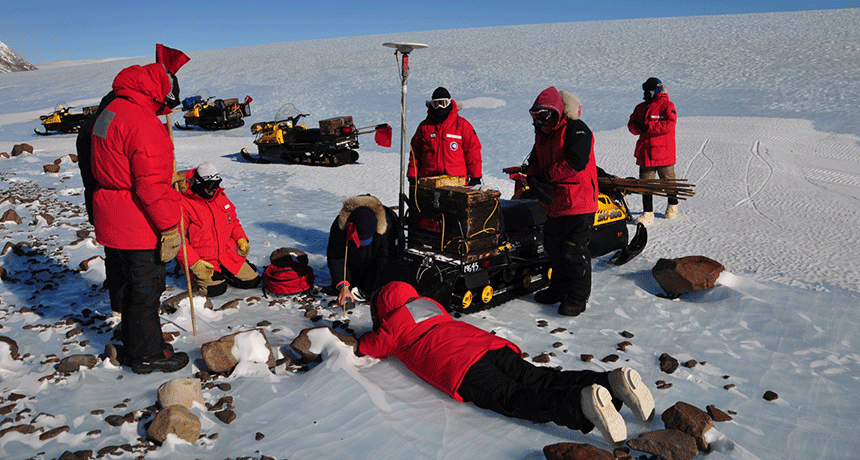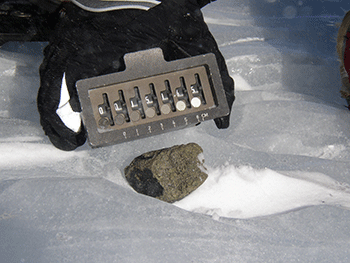
It’s a clear summer day in the Transantarctic Mountains. Being January, the temperature here in the vast emptiness of Antarctica is a relatively balmy minus 18 degrees Celsius (0 Fahrenheit). Geologist Stanley Love normally works in Houston, Texas. Now he and six others scientists were zipping across the dazzling white ice on snowmobiles. They were loaded with tents, stoves, sleeping bags and food. For the next six weeks, this team would be camping on Earth’s coldest, most hostile continent. Harsh? Absolutely. But it’s the only way to accomplish their mission: finding meteorites.
Meteorites are rocks from space that have crash-landed on Earth. Before they land, they’re called meteors. They can light the sky as “shooting stars.” Once here, they can teach us things we can’t learn from Earth rocks. Many meteorites are old. They date from the early days of our solar system, 4.6 billion years ago. No Earth rocks are that old. Meteorites also can carry clues about where they came from, which might be the moon or Mars. No wonder scientists are in hot pursuit of them.
Plenty of meteors enter Earth’s atmosphere each year. Most burn up. Still, many reach our planet’s surface. Up to 84,000 meteorites bigger than a marble fall to Earth every year.

That’s a lot of meteorites. But most are nearly impossible to find. They may be hidden by plant leaves. Or they might be mixed up with Earth rocks. Or, they might have sunk into deep water. But in the vast emptiness of Antarctica, spotting meteorites can be as easy as black on white. That’s why, for decades, teams of scientists like Love’s have braved Antarctica’s extreme conditions to look for them. A research group called the Antarctic Search for Meteorites, or ANSMET, coordinates these expeditions.
When a meteorite lands in Antarctica, it has already traveled more than 1,600,000 kilometers (about a million miles) through space. Once picked up by scientists like Love, it now begins a new journey. The rocks eventually travel to the Washington, D.C. area. They go to the Smithsonian Institution’s meteorite library. And from there, tiny pieces of the rocks journey all over the world. They are lent to scientists who probe them for clues to Earth’s beginnings — and even hints of alien life.
On the hunt
Out on the ice, Love and his colleagues spot a dark speck. Like hunters on a chase, the team of snowmobile riders swerve toward it.
The rock is about the size of a golf ball. Is it a meteorite? Chances are good. After all, out here, where else would a rock come from but from the sky? Still, the scientists look for surefire clues. The rock is dark and dense. And it has a fusion crust — the melted coating formed by intense heat as it fell though Earth’s atmosphere.

Success! This one is indeed a meteorite.
With the space rock on board, the scientists zoom off again. They’re scanning the vast whiteness as they speed across the snow. Love and his team zip to the next spot. Meanwhile, another ANMSET team has picked up even more meteorites. They label one little rock RBT 04262. RBT stands for Roberts Massif, the area in Antarctica’s Transantarctic Mountains close to where it was found. The 04 identifies the year: 2004. The next three numbers, 262, identify the meteorite as the 262nd to be collected that season.
In an average six-week field season, ANSMET teams will collect 550 meteorites. That’s far more than at any other location on Earth.
“It isn’t just that meteorites are easy to spot here,” says Love. “The flow of the ice can actually concentrate the rocks.” The ice is slowly moving, he explains. The flow can concentrate meteorites in certain places, such as against mountains where old ice is brought to the surface. What’s more, Antarctica’s dry frozen environment keeps them preserved. In addition, the constant winds scour the ice. That can expose meteorites that might have landed hundreds of thousands of years earlier.
Besides being a geologist, Love has another great qualification for an Antarctic meteorite hunter. He’s an astronaut at NASA. He served on NASA training expeditions to practice for the intense conditions in space. (NASA is short for the National Aeronautics and Space Administration.) Then, in 2008 he spent 12 days on a mission to the International Space Station. Such out-of-this-world experiences have surprising similarities to camping on a remote ice sheet. It’s the isolation. Living in seclusion with a small group is a challenge no matter where you are. And in both places, even daily routines can be out-of-this world tough. For example,” Love points out, “it’s super hard to take a bath.”

To weather such a trip, whether it’s to Antarctica or space, you need to be even-keeled, he adds, and not easily stressed. Otherwise, “little…
The post Hot on the trail of Antarctic meteorites appeared first on FeedBox.